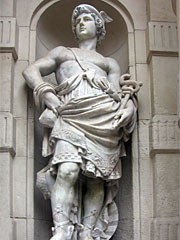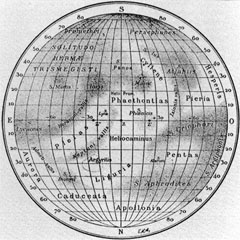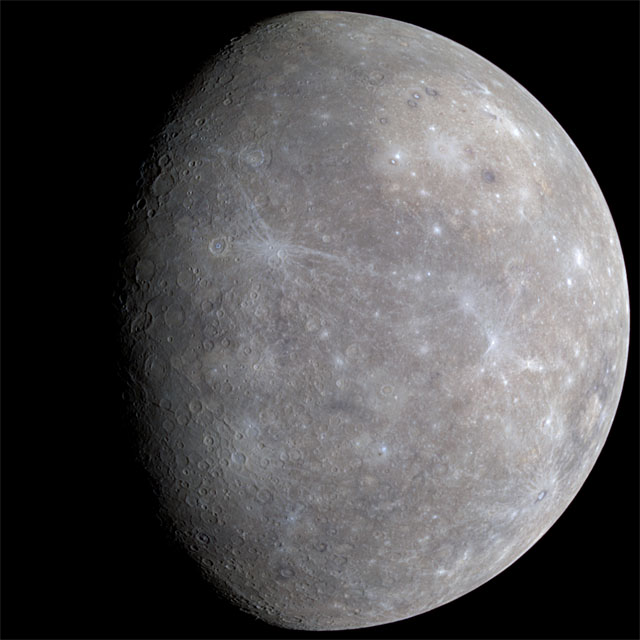

| Archive Blog Cast Forum RSS Books! Poll Results About Search Fan Art Podcast More Stuff Random |
|
Classic comic reruns every day
|
1 {photo of the planet Mercury}
1 Caption: Messenger of the Gods
|
First (1) | Previous (3238) | Next (3240) || Latest Rerun (2885) |
Latest New (5380) First 5 | Previous 5 | Next 5 | Latest 5 Annotations theme: First | Previous | Next | Latest || First 5 | Previous 5 | Next 5 | Latest 5 This strip's permanent URL: http://www.irregularwebcomic.net/3239.html
Annotations off: turn on
Annotations on: turn off
|
 Mercury, the god. Creative Commons Attribution-NonCommercial image by A. Currell, from Flickr. |
The Romans liked the sound of this and pretty much adopted Hermes wholesale, except that they gave him a new name. The Latin word for trade was mercari, and so the Romans called their adopted god of trade Mercury. This name was later used by alchemists for the peculiar liquid metal which still bears the name in modern English, because it seemed a good match to a god whose chief aspects were quickness and mobility.
Another thing the Romans adopted from the Greeks was the tradition of a seven-day week, and naming the days after various gods. The Greeks had a "day of Hermes", which became dies Mercurii in Latin, "day of Mercury". This etymology can be seen in Latin-based languages[2] today: in Italian this day of the week is now called mercoledi, in French it is mercredi, and in Spanish it is miércoles. English, on the other hand, is a Germanic language, but there is still a connection. The Romans conquered the Germanic tribes of central Europe and introduced their gods there. The native people adapted them and identified them with their own gods. The connection is not as direct as with Hermes, but Mercury became associated as an aspect of the god Woden, based mainly on his role as the divine escort of the recently deceased. Where the Romans had the day of Mercury, the Anglo-Saxons inherited Woden's day, or in modern English, Wednesday.
There was another thing that the Romans named after gods. It was obvious to the ancients that the night sky contained two different sorts of things. Firstly, there were stars. These were the most obvious, as they spangled across the entire night sky, from horizon to horizon, in a beautiful carpet of twinkling dots. Over the course of a night, the stars moved across the sky in an orderly fashion, rising in the east and setting in the west, much as the sun does during the course of a day. The stars occurred in patterns or shapes, forming a join-the-dots mosaic of pictures across the sky. Certain shapes resembled objects or mythological figures, and were given names to identify them. These patterns, and the relationships between them, maintained themselves throughout the night, and from night to night. If Orion the Hunter directed his wrath against Taurus the Bull on one night (as he did), he would do so for all eternity. The stars wheeled around the sky, making it obvious that they were attached in place to some sort of celestial sphere that rotated around the Earth.
 Moon (centre) and Mercury (right). Creative Commons Attribution-NonCommercial image by Luis Argerich, from Flickr. |
Interestingly, although the moon was back amongst the same stars every 27 and a bit days, by this time the stars had shifted their positions a bit with respect to the sun. The sun too moved amongst the stars, although it was tricky to detect because during the day the brightness of the sun hid the stars. Nevertheless, if you tracked the position of the sun against the stars that you knew should be there by assuming the stars covered the entire sphere of the sky, the sun moved a little more slowly than the stars, and returned to its original position after roughly 365 days. The tricky thing is that the phases of the moon didn't track with the position of the moon amongst the stars - they changed with the position of the moon relative to the sun. So although the moon returns to its position amongst the stars every 27 days, the phases of the moon repeat on a cycle that is a bit longer: about 29 and a half days. This period of time was actually named after the moon, and eventually entered English as the month.
But the moon and the sun weren't the only things that moved amongst the stars. There were much smaller points of light, that looked just like stars to anyone who glanced at them. But if you paid attention to where they were over a series of nights, you would notice that they too moved amongst the stars. More slowly than the moon, but just as inexorably. There were five of these "wandering stars", and that's exactly what the Ancient Greeks called them. In the Ancient Greek language, this term was αστηρ πλανητης, or aster planetes. So to the Romans, they became the planets, or "wanderers". The Greeks and Romans—and many other cultures around the world who also identified these wandering stars as special—identified the planets as gods.
 Antoniadi's map of Mercury. Public domain image, from NASA. |
The planets remained little more than mysterious, mystical pinpoints of light in the sky for almost two millennia, until 1610. In that year, Galileo Galilei turned his first telescope to the sky, and to the planets in particular. What he saw of the two slowest moving planets was astonishing, but is a story for later. Mercury remained just a dot of light until Giovanni Zupi looked at it with a better telescope in 1639. He observed that Mercury showed phases, changing shape like the moon, relative to its position with the sun.
By the 19th century, it had been established that the planets were spherical bodies somewhat like our own Earth, revolving around the sun. This meant they presumably had surface features like mountains and oceans and deserts. In the 1880s, Giovanni Schiaparelli attempted to map these features by drawing what he saw on the face of Mercury through his telescope[3]. Eugène Antoniadi continued Schiaparelli's work on Mercury, publishing an atlas of the planet in 1934. He adopted Schiaparelli's hypothesis that Mercury rotated on its axis once every 88 days, matching the length of its orbital period around the sun, and thus always showed the same face to the sun. This was not a bad assumption, as the physics of orbiting bodies causes tidal forces that tend to make the smaller object slow its rotation to match its orbital period. (This is why our moon always shows the same face towards Earth.) The effect is stronger the closer the orbiting body, so if any planet was to show this property it would be Mercury. Based on this assumption, Schiaparelli and Antoniadi mapped out rough light and dark features that they thought they could see through their telescopes. Their maps were the best we had for 40 years.
 Mariner 10 photos of Mercury. Public domain image, by NASA. |
NASA launched Mariner 10 1973, and the spacecraft flew past Mercury for the first time on 29 March, 1974. It went into an orbit around the sun that brought it back near Mercury two more times over the next year, before it exhausted its manoeuvring fuel supply and was switched off. Mariner provided close up photos of the surface of Mercury, revealing for the first time that it was a cratered world similar to our moon, coloured a dull beige colour with a few flecks of brown and grey for variety. Mariner also revealed information about Mercury's magnetic field, density, temperature, and that it had an extremely thin atmosphere, mostly of helium atoms loosely bound to the planet. On top of this, it confirmed the Arecibo radar observations and the 59-day rotation period.
This was actually not such a disaster for Antoniadi's maps as you might imagine. It turned out the rotation period was exactly 2/3 of Mercury's orbital period. This means that at the same position on every second orbit it shows the same face to the Earth, rather than on every orbit. The features Antoniadi saw through his telescope were difficult to make out at the best of times, so the fact that they were vague on every second orbit (because they were on the other side of the planet at the time) didn't seem like a big problem. And in fact some of Antoniadi's features map reasonably well on to real features observed by Mariner, so some of his original names have been preserved in modern nomenclature for the planet.
In some sense, Mercury is a very dull planet, compared to the others. But its crater-pocked surface tells a story that is important for our understanding of the solar system and how it was formed. Until 1974, we knew of only one heavily cratered body in our solar system: our own moon. This meant that smaller objects had crashed into it at some stage, but when and why were open questions. One theory of formation posited that the planets condensed through gravitational attraction from a supply of dust swirling around a central concentration that would become our sun. As different bodies accumulated mass, the matter in the planetary disc would separate into numerous rocky bodies of various sizes. The largest ones would grow to become planets by attracting smaller objects to crash into them - these smaller objects we may call asteroids. Eventually, the large outer planets grew to a size where they could disrupt the orbits of vast numbers of remaining asteroids in the outer solar system, sending many hurtling inwards to the small rocky planets there. This period of late heavy bombardment, roughly 4 billion years ago, would leave vast numbers of craters on the inner solar system bodies, and explain the appearance of our moon.
 MESSENGER image of Mercury. Public domain image, by NASA, from Wikimedia Commons. |
Only two spacecraft have visited Mercury. Mariner 10 was followed by NASA's MESSENGER mission, launched in 2004. It too made three flybys, but then settled into orbit about Mercury in March 2011. It has been mapping the surface of the planet in detail ever since, and is still active today. MESSENGER was sent to try to answer two of the most puzzling aspects of Mercury: It is extremely dense, meaning it must have a very large iron core compared to the other terrestrial planets. And secondly it has a much stronger magnetic field than anyone expected before Mariner arrived and measured it. A third mission to Mercury, the joint European-Japanese BepiColombo mission is currently shceduled to launch in 2015, and will further analyse the planet to answer these questions.
Mercury also provided an important test for another scientific theory. Mercury's orbit is far from circular - it forms an ellipse around the sun, with its closest approach (the perihelion) being 46 million kilometres, and the farthest distance from the sun (the aphelion) nearly 70 million kilometres. This orbital ellipse is not static in space, though. The perihelion slowly rotates around the sun - in the case of Mercury it moves around the sun by 5600 seconds of arc (about one and a half degrees) per century. This is very slow, but it can be measured very accurately. This precession of Mercury's orbit can be explained by the action of gravitational forces on the planet, from the sun and other planets in the solar system.
The trouble is, if you do the sums using Isaac Newton's groundbreaking description of gravity from 1686, you calculate that Mercury's orbit should precess by 5557 arcseconds per century, a discrepancy of 43 arcseconds with observation[4]. Urbain Le Verrier made this calculation in 1859 and pointed out the problem. In such cases, who is right: Isaac Newton, or the universe?
The universe! For the next 56 years the mystery remained unexplained. Astronomers tried to explain it by positing undiscovered planets that would influence Mercury's orbit, but none were found. But in 1915, Albert Einstein reformulated Isaac Newton's gravity, describing it in a different way as the curvature of space-time. The differences between these two descriptions are far too small to be noticed on scales easily testable on Earth. But when applied to the mechanics of orbiting planetary bodies, general relativity gave slightly different answers to Newton's gravity. And in the case of the precession of Mercury, general relativity produced exactly the rate of precession actually observed. This was the biggest early success of Einstein's theory, and went a long way to cementing it as a better description of gravity than Newton's. Since then, general relativity has been tested far more thoroughly in many different ways, and come up trumps each time.
But our modern understanding of gravity and how it affects the structure and evolution of the universe around us began with observations of our smallest and fastest planet. As the apple tree was to Newton, Mercury is to Einstein. Not bad for a messenger god that the Romans adopted from the Greeks.
[1] "As swiftly as a bird" may not sound all that fast to modern ears, but this was a time when the fastest that a human could possibly travel was on a horse. Birds had them beat, wings down.
[2] Also known as Romance languages. Not because French or Italian are considered to be "the language of love", but because they derive from the language of the Romans.
[3] We'll learn more about Schiaparelli in a later annotation.
[4] These numbers of 5600 and 5557 are relative to the Earth. Other sources report figures based on a frame formed by reference to distance objects far outside our galaxy, which results in an observed precession of 574 seconds of arc per century. If you calculate Newton's gravity in this frame, you get 531 arcseconds per century, still 43 arcseconds smaller than observed. The absolute numbers are different depending on what you choose as your reference, but the discrepancy is exactly the same. This explains the differences you may see regarding these numbers in some places on the web.
|
LEGO® is a registered trademark of the LEGO Group of companies,
which does not sponsor, authorise, or endorse this site. This material is presented in accordance with the LEGO® Fair Play Guidelines. |